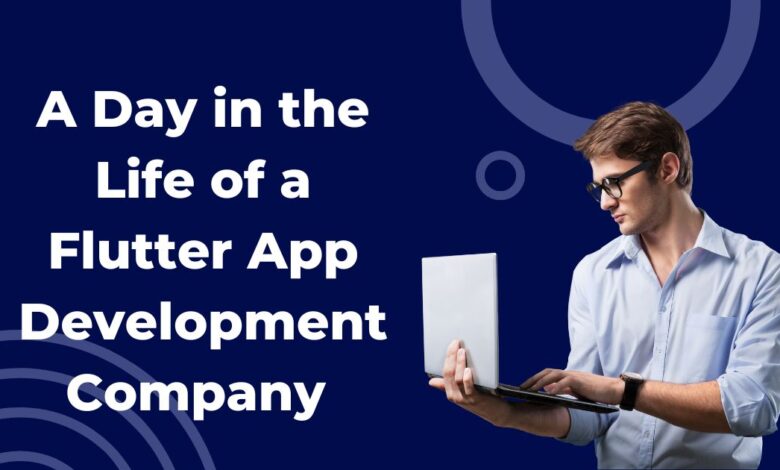A Day in the Life of a Flutter App Development Company in 2024

The world of mobile application development has evolved rapidly, and Flutter, an open-source UI software development toolkit created by Google, has emerged as a dominant player. Flutter allows developers to create natively compiled applications for mobile, web, and desktop from a single codebase. In 2024, the demand for Flutter app development companies is higher than ever, driven by the need for fast, efficient, and aesthetically pleasing applications. This article delves into a typical day in the life of a Flutter app development company, showcasing the intricacies of their operations, the roles involved, and the processes that lead to the creation of successful applications.
Flutter, introduced by Google in 2017, has revolutionized the way developers approach cross-platform app development. With a single codebase, developers can create applications that run seamlessly on multiple platforms, including iOS, Android, web, and desktop. This capability significantly reduces development time and cost while maintaining high performance and native-like user experiences.
In 2024, Flutter’s popularity continues to grow, driven by its robust framework, rich set of pre-designed widgets, and strong community support. Flutter app development companies are at the forefront of this technological wave, leveraging Flutter’s capabilities to deliver cutting-edge applications for various industries.
The Structure of a Flutter App Development Company
A successful Flutter app development company comprises several key roles and departments, each contributing to the overall process of app creation. The typical structure includes:
- Project Managers: Oversee projects, ensuring they are delivered on time and within budget.
- Developers: Write and maintain the codebase, implementing new features and fixing bugs.
- Designers: Create the visual elements of the app, ensuring an intuitive and attractive user interface.
- Quality Assurance (QA) Testers: Test the app to identify and resolve issues before release.
- Business Analysts: Gather requirements from clients and translate them into technical specifications.
- DevOps Engineers: Manage the CI/CD pipelines, ensuring smooth deployment processes.
Each of these roles plays a crucial part in the development lifecycle, working together to ensure the successful delivery of high-quality applications.
Morning Routine: Setting the Stage for Success
A typical day in a Flutter app development company begins with the morning routine, a critical period where team members prepare for the day ahead.
1. Checking Emails and Messages
The first task for most team members is to check their emails and messages. This step ensures that everyone is aware of any updates, client communications, or important notifications from the previous day.
2. Reviewing the Day’s Agenda
Project managers typically distribute the day’s agenda, outlining the tasks and goals for the day. This agenda helps team members prioritize their work and align their efforts with the project’s overall objectives.
3. Preparing Workstations
Developers, designers, and testers set up their workstations, ensuring they have all the necessary tools and resources ready for the day. This preparation includes opening relevant software, setting up development environments, and reviewing any pending tasks from the previous day.
Daily Stand-Up Meetings: Aligning the Team
A key component of the Agile methodology, daily stand-up meetings, or “stand-ups,” are brief gatherings where team members discuss their progress, plans, and any obstacles they are facing.
1. Structure of Stand-Up Meetings
Stand-up meetings typically follow a structured format, where each team member answers three questions:
- What did you accomplish yesterday?
- What are you working on today?
- Are there any blockers or issues impeding your progress?
2. Benefits of Stand-Up Meetings
Stand-ups provide several benefits, including:
- Enhanced Communication: Ensures everyone is on the same page and aware of the project’s status.
- Early Problem Identification: Helps identify and address issues before they escalate.
- Team Cohesion: Fosters a sense of collaboration and accountability within the team.
Development Phase: Bringing Ideas to Life
The core of any Flutter app development company is the development phase, where ideas are transformed into functional applications. This phase involves several critical activities and processes.
Code Review and Pair Programming
Code review is a process where developers inspect each other’s code to ensure it meets quality standards and follows best practices. This practice helps:
- Maintain Code Quality: Ensures code is clean, efficient, and free of bugs.
- Knowledge Sharing: Allows developers to learn from each other’s approaches and techniques.
Pair programming is another practice where two developers work together at one workstation. One writes the code (the driver), while the other reviews each line of code as it is written (the observer). This approach enhances collaboration and reduces the likelihood of errors.
Continuous Integration and Continuous Deployment (CI/CD)
CI/CD pipelines are essential in modern software development, automating the process of integrating code changes and deploying them to production environments.
- Continuous Integration (CI): Developers frequently merge their code changes into a shared repository, where automated builds and tests are run to catch issues early.
- Continuous Deployment (CD): Automates the release of code to production, ensuring that updates are delivered quickly and reliably.
CI/CD pipelines increase development speed, reduce manual errors, and ensure that the application is always in a deployable state.
Design and User Experience: Crafting the Look and Feel
The design and user experience (UX) team plays a pivotal role in creating applications that are not only functional but also visually appealing and easy to use.
1. User Research and Wireframing
Designers start by conducting user research to understand the target audience’s needs and preferences. This research informs the creation of wireframes, which are basic, low-fidelity representations of the app’s layout and structure.
2. Prototyping and User Testing
Once wireframes are approved, designers create high-fidelity prototypes that closely resemble the final product. These prototypes are tested with real users to gather feedback and make necessary adjustments.
3. UI Design
The final step in the design process is creating the user interface (UI). Designers use tools like Figma or Adobe XD to craft the visual elements, ensuring consistency with the brand’s identity and providing an intuitive user experience.
Quality Assurance: Ensuring Excellence
Quality assurance (QA) is a critical phase in the development lifecycle, focused on identifying and resolving issues before the application is released.
Automated Testing
Automated testing involves using scripts and tools to test the application. Common types of automated tests include:
- Unit Tests: Test individual components or functions.
- Integration Tests: Ensure that different components work together as expected.
- UI Tests: Simulate user interactions and verify that the UI behaves correctly.
Automated tests are run frequently to catch issues early and reduce the manual testing burden.
Manual Testing
Despite the advantages of automated testing, manual testing is essential for identifying issues that automated tests might miss. QA testers manually interact with the application, exploring different scenarios and edge cases to ensure comprehensive coverage.
Bug Tracking and Reporting
Identified bugs are logged into a bug tracking system, where they are prioritized and assigned to developers for resolution. This system ensures that all issues are tracked and addressed systematically.
Client Collaboration and Feedback Loop
Client collaboration is crucial for ensuring that the final product meets their expectations and requirements.
Regular Updates and Demos
Project managers provide regular updates to clients, showcasing progress and seeking feedback. These updates often include demos of new features or improvements, allowing clients to see the app in action and provide input.
Feedback Integration
Client feedback is integrated into the development process, with adjustments made as necessary to align the product with the client’s vision. This iterative approach ensures that the final product is closely aligned with client expectations.
Afternoon Check-In: Tracking Progress and Resolving Issues
Midway through the day, teams often conduct an afternoon check-in to review progress and address any emerging issues.
Progress Tracking
Project managers track the progress of tasks and milestones, ensuring that the project stays on schedule. This tracking involves reviewing task boards, burn-down charts, and other project management tools.
Issue Resolution
Any issues or blockers identified during the morning or stand-up meetings are addressed. This process may involve additional discussions, brainstorming sessions, or technical problem-solving to find effective solutions.
Training and Skill Development: Staying Ahead of the Curve
The tech industry is constantly evolving, and staying current with the latest trends and technologies is essential for any Flutter app development company.
Continuous Learning
Team members are encouraged to engage in continuous learning through:
- Online Courses and Tutorials: Platforms like Udemy, Coursera, and Pluralsight offer courses on the latest Flutter developments and best practices.
- Workshops and Webinars: Attending workshops and webinars hosted by industry experts provides valuable insights and networking opportunities.
- Reading and Research: Keeping up with industry blogs, forums, and research papers ensures that the team is aware of the latest trends and innovations.
Internal Training Sessions
Companies often organize internal training sessions where team members share their knowledge and experiences. These sessions foster a culture of learning and collaboration, helping the team stay at the forefront of technology.
Wrap-Up and Reflection: Closing the Day
As the day comes to a close, team members wrap up their tasks and reflect on the day’s achievements and challenges.
Daily Wrap-Up Meetings
Similar to stand-up meetings, wrap-up meetings provide an opportunity for team members to share their progress and any remaining issues. These meetings help ensure that everyone is prepared for the next day and that no critical tasks are left unattended.
Documentation and Reporting
Team members document their work, including any code changes, design updates, or testing results. This documentation is essential for maintaining a clear project history and ensuring that all team members have access to the latest information.
Reflection and Improvement
Reflecting on the day’s work helps identify areas for improvement. Teams discuss what went well and what could be improved, fostering a culture of continuous improvement and excellence.
Challenges and Opportunities in 2024
The landscape of Flutter app development in 2024 presents both challenges and opportunities.
Challenges
- Rapid Technological Changes: Keeping up with the fast-paced changes in technology and frameworks can be challenging.
- High Client Expectations: Clients expect high-quality, feature-rich applications with quick turnaround times.
- Talent Acquisition and Retention: Attracting and retaining skilled developers, designers, and testers is a constant challenge.
Opportunities
- Expanding Market: The demand for cross-platform applications continues to grow, providing ample opportunities for Flutter app development companies.
- Innovation and Creativity: Advances in technology open new possibilities for innovative and creative app solutions.
- Community Support: The strong and growing Flutter community provides valuable resources, support, and collaboration opportunities.
Conclusion
A day in the life of a Flutter app development company in 2024 is dynamic and multifaceted, involving a blend of development, design, testing, and client collaboration. The process is driven by a commitment to quality, innovation, and continuous improvement, ensuring that the applications delivered meet the highest standards. Despite the challenges, the opportunities for growth and success in the Flutter app development space are immense, promising an exciting future for companies and developers alike.



